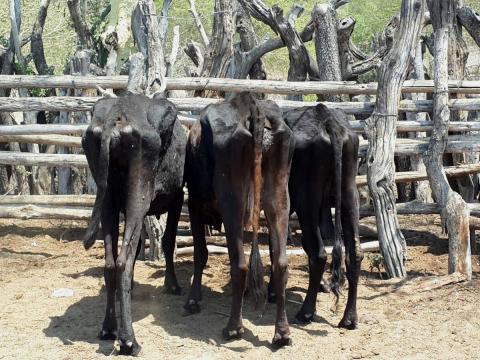Cattle die as El Nino impacts Swaziland farmers

"I never thought I will have graves for my cattle, but now I do,” said Ntombikayise Magagula – a mother and farmer living in the Lubombo region of Eastern Swaziland. “Most of us now opt to bury our dead cows to prevent foul smell and disease. What is happening to us and our livestock is very painful, we feel so powerless about this situation.”
The current drought in Lubombo means Ntombikayise has had to take some of her cows to an impromptu auction of livestock. It’s held at the Dipping Tank – a dusty area, with no sign of grass for the cattle to graze on.
According to the Lubombo Regional Animal Inspector, Dumezweni Simelane, last month alone more than 360 cattle died in this area, due to water and food shortages. Local dams and rivers have dried up and the land is completely parched.
Before the drought, Ntombikayise had 19 cattle. Seven have already died and today she has brought a further three to the auction.
Before the drought, Ntombikayise had 19 cattle. Seven have already died and today she has brought a further three to the auction.
"The reason I am selling the cattle is that I want to buy hay bales to feed the remaining cows before they die. I chose the better ones so that people can buy them. Even though the value has depreciated, I am hoping for the best. We also need food at home and the children are really affected by this. At least they have a feeding scheme at the school," she said.
Ntombikayise’s cows sold at the auction for E9,650 (US$742). In better days the three cattle would have fetched almost double.
Ntombikayise has sought solace in the little gains she has made from the auction, which also enabled her to register for bales of hays through Government Agricultural Extension Workers. "I cannot say I am happy, but under the circumstances, I am grateful that at least I will be able to buy food for my children and family, and possibly save the rest of my cattle,” she said.
Bales of hay are being imported from South Africa, at a cost of around E550 (US$42).
According to John Tsabedze, another farmer at the auction, last week he bought bales for E500 (US$38). “We are not sure how much the price will be in the near future and most people do not afford them. Cattle no longer have the luxury of feeding ad libitum.”
John says each bale of hay will last ten cows for two days.
With the peak of El Nino expected in December 2015 and January 2016 World Vision is concerned about the increased impact this could have on families in Swaziland and other affected countries.
Share